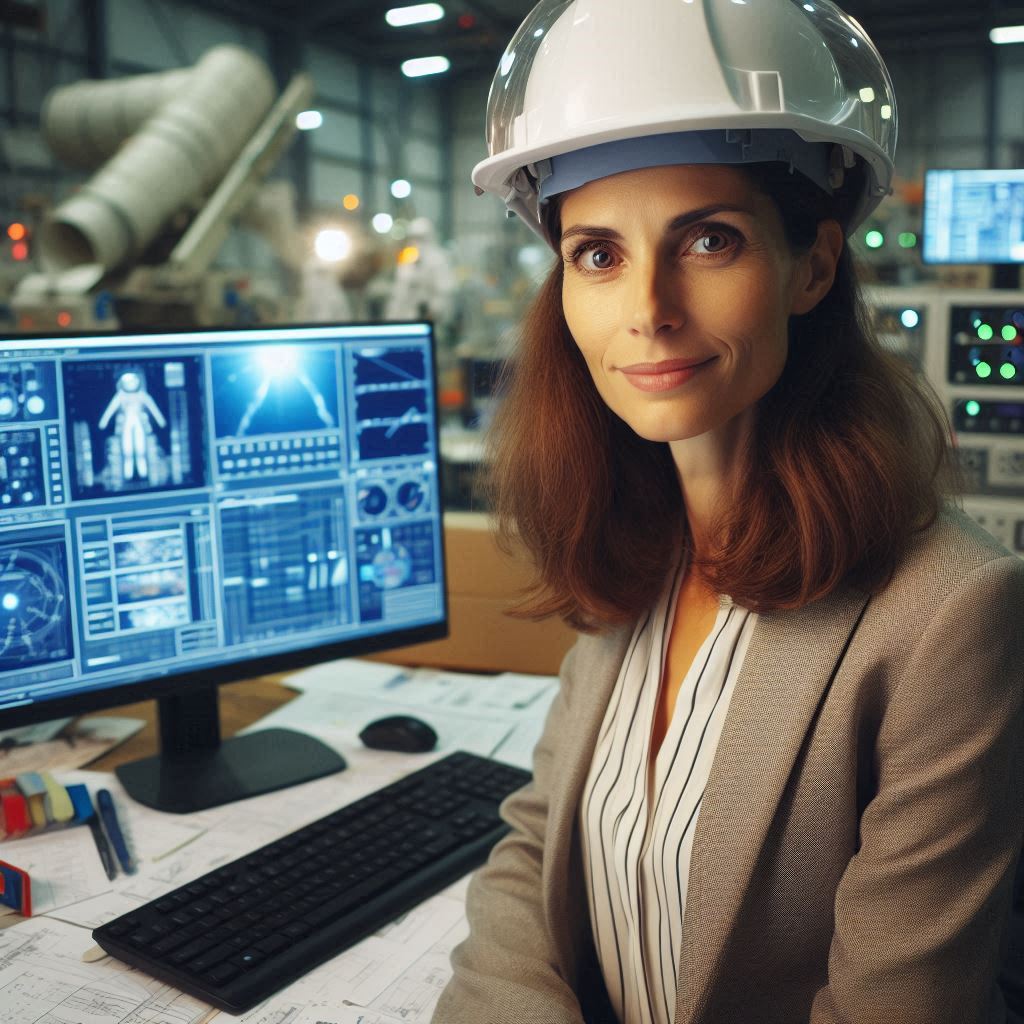Introduction
Aerospace engineering is a dynamic field that focuses on the design, development, and testing of aircraft and spacecraft.
This discipline plays a crucial role in space missions, providing the technology and expertise needed to venture beyond our planet.
The importance of aerospace engineering in space exploration cannot be overstated.
Engineers in this field develop rockets, satellites, and space vehicles that make space exploration possible, ensuring these technologies operate efficiently and safely in the harsh environment of space.
Aerospace engineering’s contributions to space missions are vast and varied.
They encompass advancements in propulsion systems, innovative spacecraft designs, and cutting-edge materials that withstand the extreme conditions of space.
From launching satellites that revolutionize communication and weather forecasting to developing spacecraft that explore distant planets, aerospace engineers drive the success of space missions.
These contributions enable humanity to push the boundaries of knowledge, achieve scientific breakthroughs, and inspire future generations of explorers and scientists.
Aerospace engineers are at the forefront of space exploration, continuously pushing the limits of what is possible.
Their work ensures that missions are not only feasible but also successful and safe.
History of Aerospace Engineering
Overview of the Origins of Aerospace Engineering
Aerospace engineering originated from the early 20th century efforts to develop powered flight.
The Wright brothers’ first successful flight in 1903 marked the beginning of this field.
Engineers initially focused on designing and improving aircraft for military and commercial use.
With the launch of the first artificial satellite, Sputnik 1, by the Soviet Union in 1957, aerospace engineering expanded to include space exploration.
This event sparked the space race, driving rapid advancements in technology and expertise.
Milestones in the Development of Aerospace Engineering for Space Missions
The Apollo program represents a significant milestone in aerospace engineering.
In 1969, NASA’s Apollo 11 mission successfully landed the first humans on the Moon.
This achievement showcased the advanced engineering required for space travel, including propulsion, navigation, and life support systems.
The development of the Space Shuttle in the 1970s and 1980s further demonstrated the progress in aerospace engineering.
The Shuttle’s reusable design marked a shift towards more sustainable and cost-effective space missions.
Another milestone was the launch of the Hubble Space Telescope in 1990.
Aerospace engineers designed and built this advanced observatory, enabling unprecedented views of the universe.
The Hubble’s success highlighted the importance of precision engineering and collaboration between scientists and engineers.
The International Space Station (ISS), launched in 1998, also stands as a testament to aerospace engineering.
Engineers from multiple countries worked together to create a modular, habitable space station that supports long-term missions and scientific research.
Examples of Breakthroughs in Aerospace Engineering That Have Shaped Space Exploration
The development of the Saturn V rocket was a groundbreaking achievement in aerospace engineering.
This powerful rocket, used in the Apollo missions, remains the most powerful rocket ever built.
Its successful design and launch capability enabled astronauts to reach the Moon and return safely.
Another breakthrough is the Mars rover program, starting with the Sojourner rover in 1997 and continuing with the Curiosity and Perseverance rovers.
Aerospace engineers developed these rovers to navigate and conduct scientific experiments on Mars, providing valuable data about the planet’s surface and environment.
The advancement of satellite technology has also significantly impacted space exploration.
Engineers developed communication satellites that revolutionized global communications, weather forecasting, and navigation systems.
The Global Positioning System (GPS), for example, relies on a network of satellites engineered to provide precise location data worldwide.
Reusable rocket technology, pioneered by companies like SpaceX, represents a recent breakthrough.
The Falcon 9 rocket’s ability to land and be reused reduces the cost of space missions and increases their frequency.
This innovation has opened new possibilities for space exploration and commercial space travel.
Role of Aerospace Engineers in Space Missions
Duties and Responsibilities of Aerospace Engineers in Space Missions
Aerospace engineers play a vital role in the success of space missions.
Their primary duties include designing, testing, and overseeing the construction of spacecraft.
They ensure that every component of a spacecraft meets strict safety and performance standards.
Engineers also develop propulsion systems, which are crucial for navigating and maneuvering in space.
Aerospace engineers are responsible for integrating various subsystems within a spacecraft.
This includes communication systems, life support systems, and power generation.
They must ensure these systems work seamlessly together to support mission objectives.
In addition to design and integration, aerospace engineers conduct extensive testing and simulations.
They use sophisticated software to model spacecraft behavior under different conditions.
This helps identify potential issues and refine designs before actual construction.
Once a spacecraft is built, aerospace engineers oversee its assembly and launch.
They work closely with technicians to ensure the spacecraft is assembled correctly and functions as intended.
They also monitor the launch process, ensuring the spacecraft reaches its intended orbit safely.
Collaboration with Other Experts in the Field
Successful space missions require collaboration among experts from various fields.
Aerospace engineers work closely with scientists, who define mission objectives and requirements.
This collaboration ensures the spacecraft is designed to support scientific experiments and data collection.
Engineers also collaborate with materials scientists to select the best materials for spacecraft construction.
These materials must withstand extreme temperatures, radiation, and the vacuum of space.
Collaboration ensures the spacecraft is durable and reliable.
Additionally, aerospace engineers work with computer scientists to develop software for spacecraft control and data processing.
This software is critical for navigation, communication, and scientific data analysis.
Project managers coordinate these collaborative efforts, ensuring all teams work towards common goals.
They oversee timelines, budgets, and resource allocation, keeping the project on track.
Impact of Aerospace Engineering on the Success of Space Missions
The contributions of aerospace engineers are crucial to the success of space missions.
Their expertise ensures spacecraft are designed to meet mission requirements and withstand the harsh conditions of space.
Reliable design and construction increase the likelihood of mission success.
Advanced propulsion systems developed by aerospace engineers enable spacecraft to travel further and more efficiently.
This expands the possibilities for exploration and scientific discovery.
The integration of subsystems ensures spacecraft can support various mission activities, from scientific experiments to communication with Earth.
This versatility is essential for achieving mission objectives.
Extensive testing and simulations conducted by aerospace engineers help identify and mitigate potential issues.
This proactive approach reduces the risk of mission failures and enhances safety.
Collaboration with other experts ensures the spacecraft is equipped with the latest technologies and materials.
This interdisciplinary approach drives innovation and improves mission outcomes.
Transform Your Career Today
Unlock a personalized career strategy that drives real results. Get tailored advice and a roadmap designed just for you.
Start NowIn general, aerospace engineers are essential to the success of space missions.
Their duties and responsibilities cover all aspects of spacecraft design, testing, and operation.
Collaboration with other experts enhances the quality and reliability of space missions.
The impact of aerospace engineering on space missions is profound, driving technological advancements and enabling humanity to explore the cosmos.
Space missions make them integral to the field of space exploration.
Innovations in Aerospace Engineering for Space Missions
Advancements in propulsion systems for spacecraft have revolutionized space exploration.
With the development of more efficient and powerful engines, spacecraft can travel farther and faster than ever before.
The use of robotics and artificial intelligence has also greatly impacted space missions.
These technologies allow for autonomous operations, reducing the need for human intervention and making tasks more precise and efficient.
Advancements in Propulsion Systems
One of the key innovations in propulsion systems for space missions is the development of ion propulsion.
This technology uses electrically charged particles to generate thrust, resulting in higher speeds over long distances.
In addition to ion propulsion, aerospace engineers have also made significant progress in developing more environmentally friendly propulsion systems.
For example, the use of non-toxic propellants reduces the impact on the environment and allows for safer handling.
Development of Materials for Spacecraft Construction
The materials used in spacecraft construction play a crucial role in the success of space missions.
Aerospace engineers have been constantly researching and developing new materials that are lightweight, durable, and able to withstand the harsh conditions of space.
One such material is carbon fiber composite, which is known for its high strength-to-weight ratio.
This material is used in various components of spacecraft, including the outer shell, to reduce weight and increase structural integrity.
Use of Robotics and Artificial Intelligence
Robotic technologies have been instrumental in exploring distant planets and moons.
Robotic rovers, for example, can traverse terrain that is too dangerous or inaccessible for humans, collecting valuable data and samples for analysis.
Artificial intelligence is also being used to optimize spacecraft operations.
AI algorithms can analyze vast amounts of data in real-time, enabling spacecraft to make autonomous decisions and adapt to changing conditions, increasing the overall efficiency of missions.
In essence, innovations in aerospace engineering have significantly enhanced the success and efficiency of space missions.
With advancements in propulsion systems, materials development, and the integration of robotics and artificial intelligence, the possibilities for space exploration are more exciting than ever before.
Read: Iconic US Buildings and the Architects Behind Them.

Challenges Faced by Aerospace Engineers in Space Missions
When it comes to aerospace engineering and space missions, there are a multitude of challenges that engineers face on a daily basis.
These challenges are not only technical in nature but also involve critical problem-solving skills to overcome obstacles.
Let’s delve into some of the key challenges faced by aerospace engineers in space missions
Limitations in Technology and Resources
- Developing cutting-edge technology for space missions requires significant resources and expertise.
- Engineers must work within the constraints of existing technology and push the boundaries of innovation.
- Improving the efficiency and reliability of spacecraft systems is an ongoing challenge in aerospace engineering.
- Balancing cost constraints with the need for advanced technology is a constant dilemma for engineers.
Environmental Factors Affecting Spacecraft Design
- The harsh conditions of space, such as extreme temperatures and radiation, pose significant challenges for spacecraft design.
- Engineers must develop materials and technologies that can withstand the rigors of space travel.
- Designing spacecraft to be resilient to environmental factors is crucial for mission success.
- Spacecraft must be engineered to operate in a vacuum environment with minimal external support.
Importance of Problem-Solving Skills in Overcoming Obstacles
- Aerospace engineers must possess strong problem-solving skills to address unexpected challenges during space missions.
- The ability to think critically and creatively is essential for overcoming obstacles in space engineering.
- Engineers must collaborate effectively with interdisciplinary teams to solve complex problems in real-time.
- Adaptability and resilience are key traits for aerospace engineers to navigate the uncertainties of space missions.
Generally, aerospace engineers play a crucial role in the success of space missions by overcoming challenges related to technology limitations, environmental factors, and problem-solving skills.
By pushing the boundaries of innovation and collaboration, engineers continue to drive advancements in space exploration and contribute to our understanding of the universe.
Read: Post-Pandemic Design Trends: US Architects Adapt
Examples of Successful Space Missions Enabled by Aerospace Engineering
Apollo Moon Landing Mission
The Apollo moon landing mission marked a monumental achievement in aerospace engineering.
Engineers designed the Saturn V rocket, a marvel of technology.
The rocket had to be powerful enough to propel astronauts to the moon and ensure a safe return.
Engineers meticulously planned every detail, from the launch to the lunar landing.
The Lunar Module, another engineering masterpiece, enabled astronauts to land on the moon’s surface.
Engineers designed it to withstand the moon‘s low gravity and harsh environment.
They also developed the Command Module, which housed the astronauts during their journey to and from the moon.
Aerospace engineers conducted rigorous testing and simulations to ensure the mission’s success.
They anticipated and solved potential problems, ensuring astronaut safety.
The Apollo 11 mission, in particular, demonstrated their expertise and dedication.
On July 20, 1969, Neil Armstrong and Buzz Aldrin successfully landed on the moon, a testament to the engineers‘ hard work.
Mars Rover Missions
Mars Rover missions showcase the ongoing contributions of aerospace engineering.
Engineers designed rovers like Spirit, Opportunity, Curiosity, and Perseverance to explore Mars‘ surface.
Each rover had to be robust, capable of navigating the harsh Martian terrain and conducting scientific experiments.
Aerospace engineers developed sophisticated landing systems to ensure safe touchdowns.
For example, the Curiosity rover used a sky crane system for a precise landing.
This innovative approach minimized impact and enabled the rover to start its mission immediately.
Showcase Your Business Today
Reach thousands of readers actively exploring professional services. Publish your business profile and grow your audience now.
Publish NowOnce on Mars, the rovers‘ mobility systems, designed by engineers, allowed them to traverse various terrains.
The rovers conducted experiments, collected samples, and sent valuable data back to Earth.
Engineers also ensured the rovers could withstand extreme temperatures and dust storms, enhancing mission longevity.
The Perseverance rover, launched in 2020, represents the pinnacle of engineering advancements.
It includes a suite of scientific instruments and the Ingenuity helicopter, the first powered flight on another planet.
These missions have expanded our understanding of Mars, paving the way for future exploration.
International Space Station Construction and Maintenance
The International Space Station (ISS) exemplifies aerospace engineering’s collaborative and innovative spirit.
Engineers from NASA, Roscosmos, ESA, JAXA, and CSA worked together to construct the ISS.
They designed modules that could be launched separately and assembled in space.
Aerospace engineers developed systems for life support, power generation, and communication.
These systems ensure the station‘s habitability and functionality.
They also created docking systems to allow spacecraft to deliver supplies and new crew members.
Maintenance is a critical aspect of the ISS’s operation.
Aerospace engineers designed tools and procedures for astronauts to perform repairs and upgrades.
This includes the development of robotic systems like the Canadarm2, which assists in station maintenance and assembly.
Engineers also work on ongoing research to improve the ISS‘s systems and extend its operational life.
They address challenges such as micrometeoroid impacts, material degradation, and system failures.
Their work ensures the ISS remains a hub for scientific research and international cooperation.
Read: Impact of Local Building Codes on US Architecture.
Future of Aerospace Engineering in Space Missions
Potential Advancements in Aerospace Engineering for Upcoming Missions
Aerospace engineering is constantly evolving, pushing the boundaries of what is possible in space exploration.
With the rapid pace of technological advancements, there are several potential developments that could revolutionize future space missions.
- Advanced Propulsion Systems: Engineers are working on next-generation propulsion systems such as ion thrusters and nuclear propulsion, which could significantly reduce travel time to distant planets.
- Autonomous Systems: Spacecraft equipped with advanced AI and machine learning capabilities could make autonomous decisions, reducing the need for constant human intervention.
- Reusable Spacecraft: Developing fully reusable spacecraft could drastically reduce the cost of space missions and make frequent travel to space more feasible.
- Advanced Materials: Lightweight and durable materials are being researched for spacecraft construction to improve efficiency and durability in harsh space environments.
Role of Aerospace Engineers in Developing New Technologies
Aerospace engineers play a crucial role in designing, testing, and implementing groundbreaking technologies that drive space exploration forward.
Their expertise is essential in bringing innovative concepts to life.
- Simulation and Modeling: Engineers use advanced simulation tools to predict the behavior of spacecraft in various conditions, optimizing designs for maximum efficiency.
- Collaborative Partnerships: Aerospace engineers collaborate with scientists, researchers, and industry experts to develop cutting-edge technologies that push the boundaries of space exploration.
- Risk Assessment: Engineers assess potential risks associated with new technologies and make informed decisions to ensure the safety and success of space missions.
- Continuous Learning: Aerospace engineers are constantly learning and adapting to new technologies and methodologies to stay ahead of the curve in the rapidly evolving field of space exploration.
Possibilities for Human Exploration of Mars and Beyond
One of the most exciting prospects in aerospace engineering is the possibility of human exploration of Mars and other celestial bodies beyond Earth.
With advancements in technology, this dream is becoming increasingly achievable.
- Space Habitats: Engineers are designing habitats that can sustain human life in space for extended periods, providing a safe and comfortable environment for astronauts.
- Life Support Systems: Advanced life support systems are being developed to ensure astronauts have access to clean air, water, and food in the harsh conditions of space.
- Regenerative Technologies: Engineers are exploring regenerative technologies that can recycle resources onboard spacecraft, reducing the need for constant resupply missions from Earth.
- Medical Innovations: Aerospace engineers are working on medical advancements to address the unique challenges of space travel, such as microgravity-induced health issues and radiation exposure.
Read: How US Architects Adapt to Climate Change Concerns
Impact of Aerospace Engineering on Society
Spinoff Technologies from Space Missions
Space missions have led to the development of numerous spinoff technologies.
Aerospace engineering has driven innovations initially intended for space but later adapted for everyday use.
One notable example is memory foam, initially developed for spacecraft seats, which is now used in mattresses and pillows.
Aerospace engineers also developed advanced water purification systems for astronauts.
These systems are now used to provide clean drinking water in remote areas on Earth.
Similarly, satellite technology, originally designed for space communication, has revolutionized global communication networks.
Medical advancements have also emerged from aerospace engineering.
MRI and CAT scan technologies were influenced by imaging techniques developed for space exploration.
Moreover, aerospace engineering contributed to the development of miniature sensors and devices, enhancing medical diagnostics and treatments.
Benefits of Aerospace Engineering in Improving Life on Earth
Aerospace engineering has significantly improved life on Earth through technological advancements and practical applications.
Satellite technology has enhanced weather forecasting, enabling better preparation for natural disasters.
Accurate weather predictions help save lives and reduce property damage.
Aerospace engineers have also contributed to advancements in transportation.
Aerodynamics research, initially aimed at improving spacecraft design, has led to more fuel-efficient and safer airplanes.
These improvements have reduced travel costs and environmental impact.
Environmental monitoring is another area where aerospace engineering has made a difference.
Satellites track climate changes, monitor deforestation, and assess natural resource depletion.
This data is crucial for making informed decisions about environmental protection and sustainability.
Moreover, aerospace engineering has driven the development of GPS technology.
GPS has become integral to navigation, agriculture, and emergency response.
Farmers use GPS for precision farming, optimizing crop yields and reducing waste.
Emergency responders rely on GPS for efficient coordination during disasters.
Inspiration for Future Generations of Engineers and Scientists
Aerospace engineering and space missions inspire future generations of engineers and scientists.
The achievements of space exploration ignite curiosity and a desire to explore the unknown.
Young minds are captivated by the idea of venturing into space and contributing to groundbreaking discoveries.
Educational programs and initiatives, inspired by space missions, encourage students to pursue STEM careers.
Organizations like NASA and ESA engage with schools and universities, offering programs that expose students to the wonders of aerospace engineering.
These initiatives foster a passion for science and engineering from an early age.
Prominent figures in aerospace, like astronauts and engineers, serve as role models for aspiring scientists.
Their stories of perseverance and innovation motivate students to pursue challenging careers in aerospace.
The legacy of space missions emphasizes the importance of dedication, creativity, and collaboration.
Aerospace engineering projects also provide opportunities for hands-on learning.
Student-led satellite projects and robotics competitions allow young engineers to apply their knowledge practically.
These experiences are invaluable in shaping the skills and confidence needed for future careers.
You Might Also Like: Internship Opportunities for Biomedical Technician Students
Conclusion
Aerospace engineering has significantly advanced space missions, enabling remarkable achievements in exploration and technology.
Innovations in spacecraft design, propulsion systems, and materials have made space travel safer and more efficient.
Engineers have developed cutting-edge technologies, from the design of robust and reliable spacecraft to the creation of powerful propulsion systems that can withstand the harsh conditions of space.
These advancements have enabled humanity to explore the far reaches of our solar system and beyond, contributing to our understanding of the universe.
Continued innovation in aerospace engineering is crucial for future space missions, ensuring progress and discovery.
As we look forward to missions to Mars, asteroid mining, and beyond, the need for novel technologies and solutions remains critical.
Innovations in areas such as autonomous systems, advanced materials, and propulsion technologies will drive the next generation of space exploration.
Investment in research and development is essential to overcome the challenges of long-duration space travel and to ensure the success of future missions.
Aspiring aerospace engineers should seize opportunities in this dynamic field, contributing to groundbreaking space exploration endeavors.
The field offers a wealth of opportunities for those passionate about space and technology.
[E-Books for Sale]
The Big Book of 500 High-Paying Jobs in America: Unlock Your Earning Potential
$19.99 • 500 High-Paying Jobs • 330 pages
Explore 500 high-paying jobs in America and learn how to boost your career, earn more, and achieve success!
See All 500 High-Paying Jobs of this E-Book
1001 Professions Without a Degree: High-Paying American Jobs You Can Start Now
$19.99 • 1001 Professions Without a Degree • 174 pages
Discover 1001 high-paying jobs without a degree! Unlock career tips, skills, and success strategies for just $19.99!




